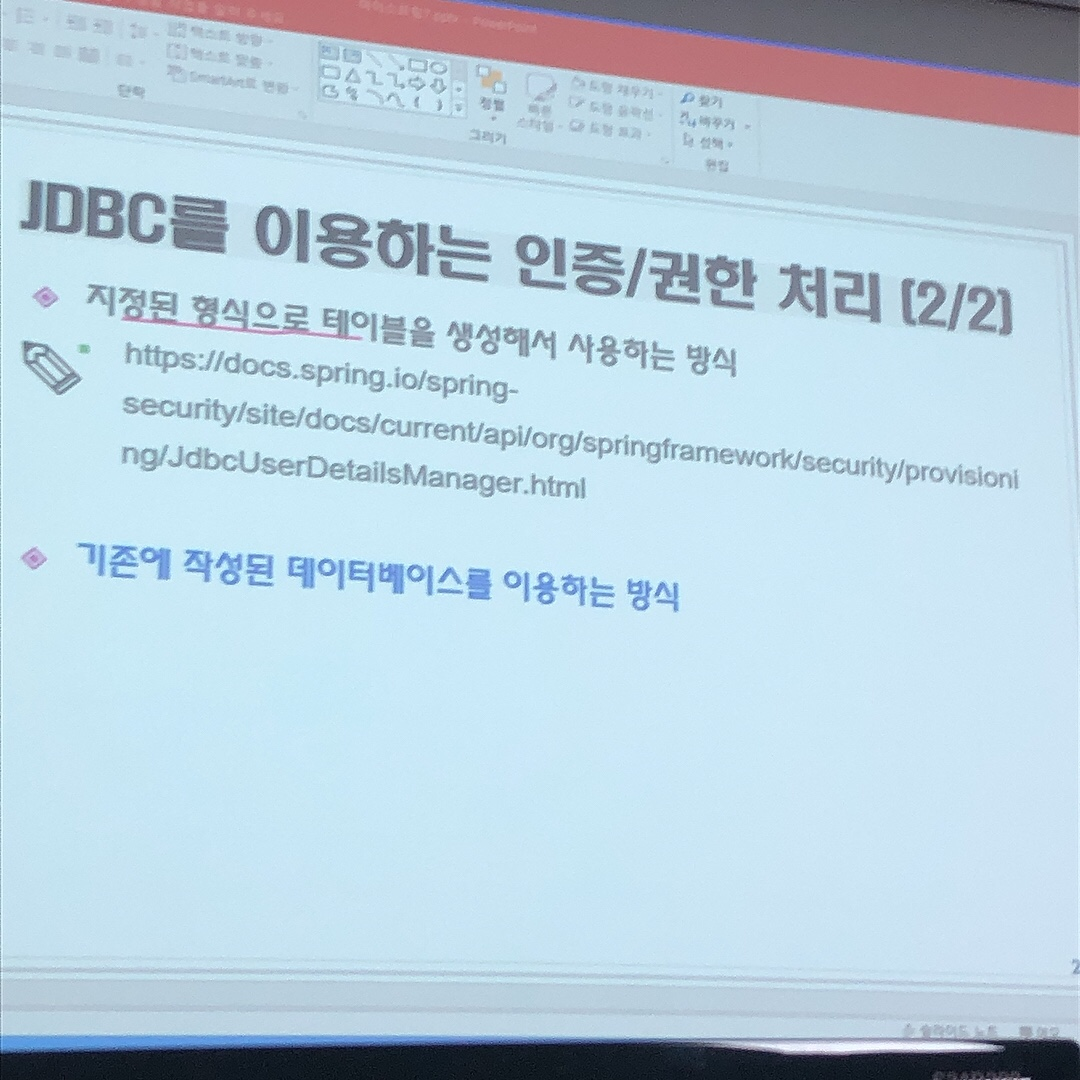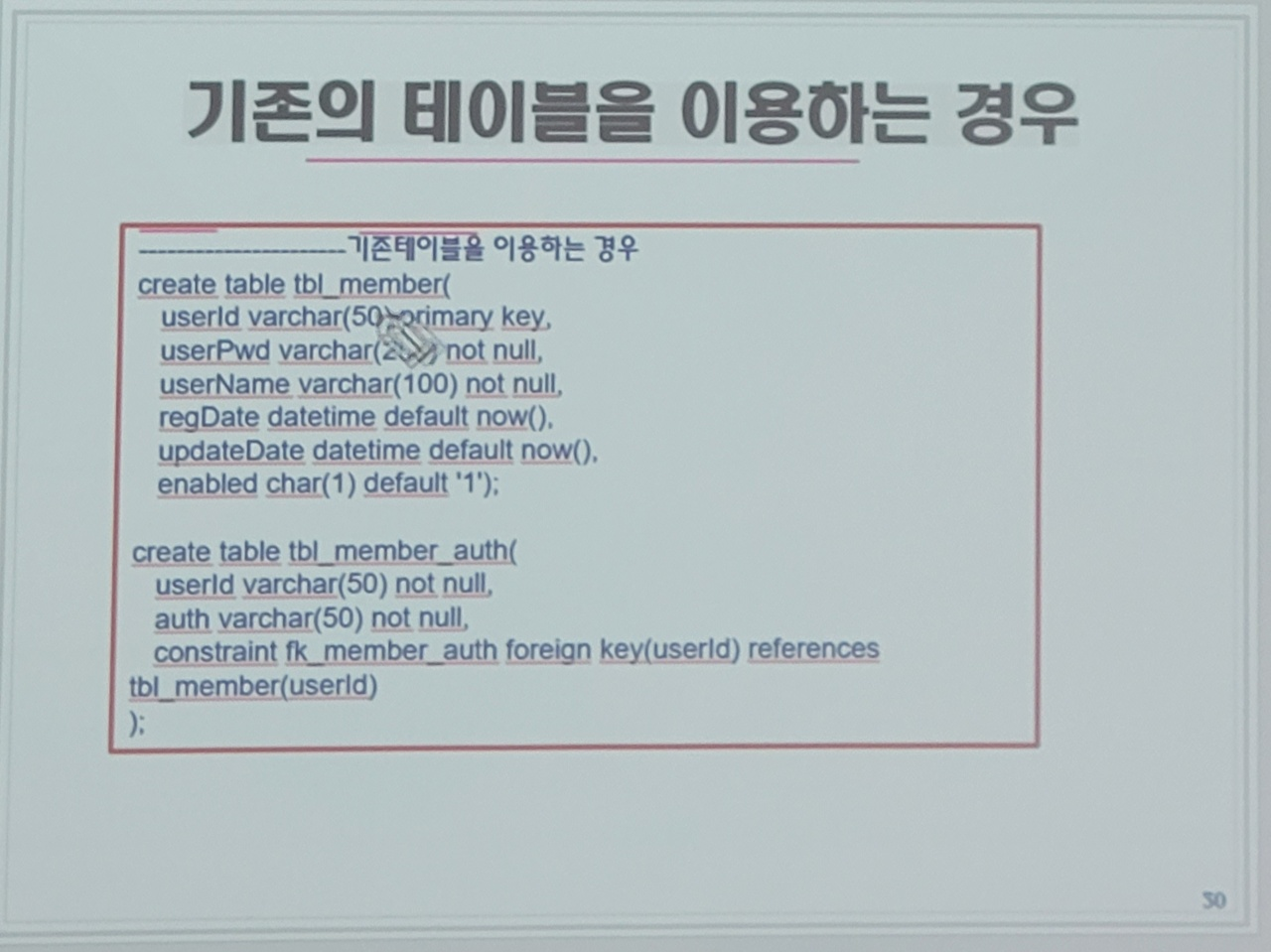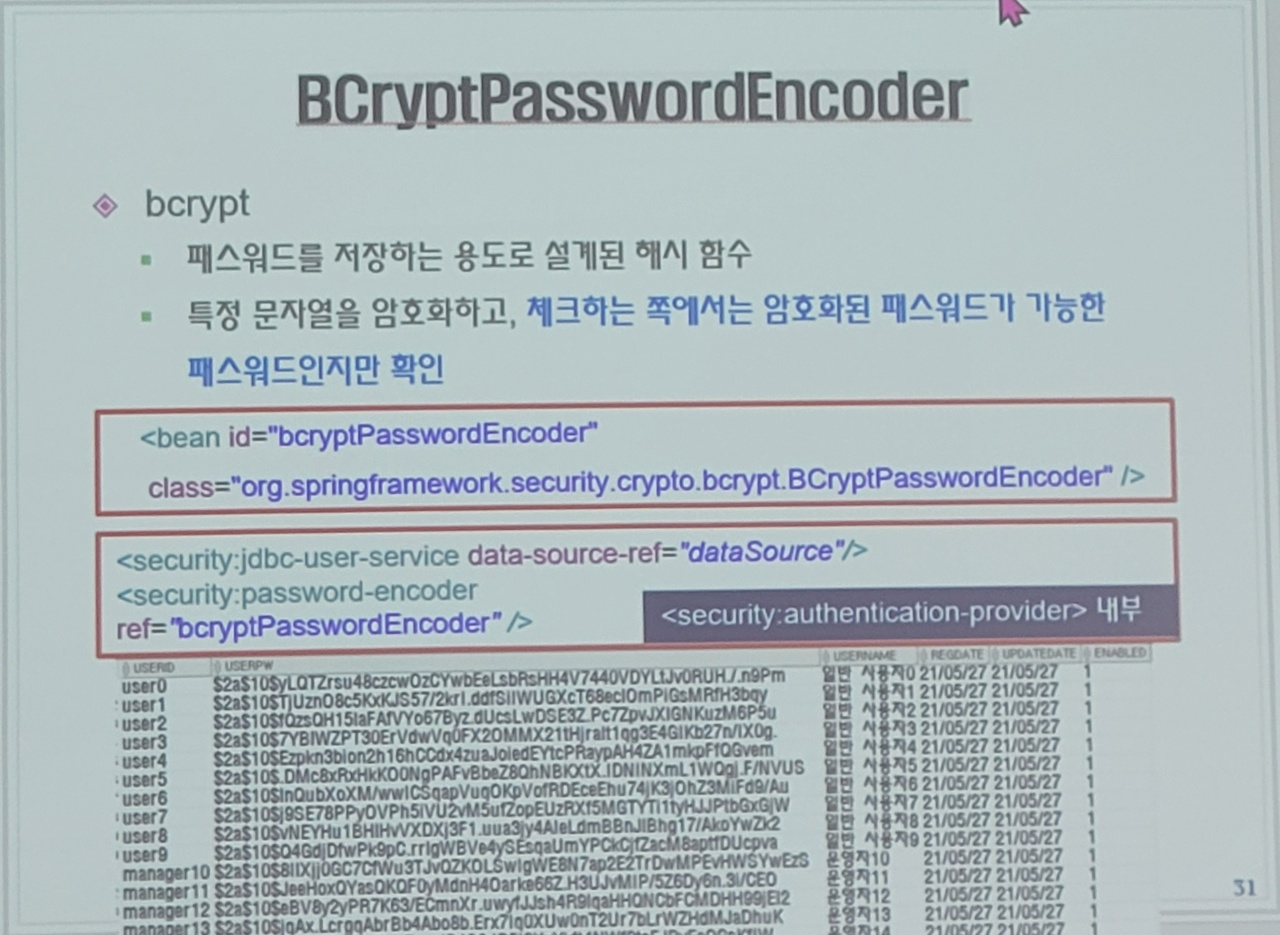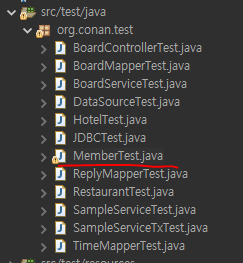

Mysql 쿼리
create table tbl_member(
userId varchar(50) primary key,
userPwd varchar(200) not null,
userName varchar(100) not null,
regDate datetime default now(),
updateDate datetime default now(),
enabled char(1) default '1');
create table tbl_member_auth(
userId varchar(50) not null,
auth varchar(50) not null,
constraint fk_member_auth foreign key(userId) references tbl_member(userId));테이블 생성한다

그 후 security.xml에다가
<!-- bcrypt : 패스워드를 저장하는 용도로 설계된 해시 함수
특정 문자열을 암호화하고, 체크하는 쪽에서는 암호화된 패스워드가 가능한 패스워드인지만 확인 -->
<security:jdbc-user-service data-source-ref="dataSource"/>
<security:password-encoder ref="bcryptPasswordEncoder"/>추가한다
security.xml 전체코드
전체코드 공유
<?xml version="1.0" encoding="UTF-8"?>
<beans xmlns="http://www.springframework.org/schema/beans"
xmlns:xsi="http://www.w3.org/2001/XMLSchema-instance"
xmlns:security="http://www.springframework.org/schema/security"
xsi:schemaLocation="http://www.springframework.org/schema/security https://www.springframework.org/schema/security/spring-security-5.2.xsd
http://www.springframework.org/schema/beans https://www.springframework.org/schema/beans/spring-beans.xsd">
<security:http auto-config="true" use-expressions="true">
<security:intercept-url pattern="/sample/all" access="permitAll" />
<security:intercept-url pattern="/sample/member" access="hasRole('ROLE_MEMBER')" />
<security:intercept-url pattern="/sample/admin" access="hasRole('ROLE_ADMIN')" />
<security:form-login login-page="/customLogin" authentication-success-handler-ref="customLoginSuccess"/>
<!-- 내가 만든 로그인 페이지(/customLogin) 를 쓰겠다고 하는거 -->
<security:logout logout-url="/customLogout" invalidate-session="true"/>
<security:access-denied-handler ref="customAccessDenied"/>
</security:http>
<security:authentication-manager>
<security:authentication-provider>
<security:user-service>
<security:user name="member" password="{noop}member" authorities="ROLE_MEMBER"/>
<security:user name="admin" password="{noop}admin" authorities="ROLE_MEMBER, ROLE_ADMIN"/>
</security:user-service>
<!-- bcrypt : 패스워드를 저장하는 용도로 설계된 해시 함수
특정 문자열을 암호화하고, 체크하는 쪽에서는 암호화된 패스워드가 가능한 패스워드인지만 확인 -->
<security:jdbc-user-service data-source-ref="dataSource"/>
<security:password-encoder ref="bcryptPasswordEncoder"/>
</security:authentication-provider>
</security:authentication-manager>
<bean id="customAccessDenied" class="org.conan.security.CustomAccessDeniedHandler"></bean>
<bean id="customLoginSuccess" class="org.conan.security.CustomLoginSuccessHandler"></bean>
<bean id="bcryptPasswordEncoder" class="org.springframework.security.crypto.bcrypt.BCryptPasswordEncoder"/>
</beans>그다음
MemberTest.java

여기에 MemberTest.java생성
그다음
test해준다
package org.conan.test;
import java.sql.Connection;
import java.sql.PreparedStatement;
import java.sql.SQLException;
import javax.sql.DataSource;
import org.junit.Test;
import org.junit.runner.RunWith;
import org.springframework.beans.factory.annotation.Autowired;
import org.springframework.security.crypto.password.PasswordEncoder;
import org.springframework.test.context.ContextConfiguration;
import org.springframework.test.context.junit4.SpringJUnit4ClassRunner;
import lombok.Setter;
import lombok.extern.log4j.Log4j;
@RunWith(SpringJUnit4ClassRunner.class)
@ContextConfiguration({"file:src/main/webapp/WEB-INF/spring/root-context.xml",
"file:src/main/webapp/WEB-INF/spring/security-context.xml"
})
@Log4j
public class MemberTest {
@Setter(onMethod_= {@Autowired})
private PasswordEncoder pwencoder;
@Setter(onMethod_= {@Autowired})
private DataSource ds;
@Test
public void testInsertMember() {
String sql = "insert into tbl_member(userid, userpwd, username) values (?,?,?)";
Connection conn = null;
PreparedStatement pstmt = null;
for(int i=0; i<30; i++) {
try {
conn=ds.getConnection();
pstmt= conn.prepareStatement(sql);
pstmt.setString(2, pwencoder.encode("pw"+i));
if(i<10) {
pstmt.setString(1, "user"+i);
pstmt.setString(3, "일반 사용자"+i);
}else if(i<20) {
pstmt.setString(1, "member"+i);
pstmt.setString(3, "운영자"+i);
}else {
pstmt.setString(1, "admin"+i);
pstmt.setString(3,"관리자"+i);
}
pstmt.executeUpdate();
}catch(SQLException e) {}
finally {
if(pstmt!=null) {
try {
pstmt.close();
}catch(SQLException e) {}
if(conn!=null) {
try {
conn.close();
}catch(SQLException e) {}
}
}
}
}
}
//생성된 사용자에 권한 추가하기
// user**에게 ROLE_USER권한
//member**에게 ROLE_MEMBER권한
//admin**에게 ROLE_ADMIN권한
@Test
public void testInsertAuth() {
String sql = "insert into tbl_member_auth(userid,auth) values(?,?)";
Connection conn = null;
PreparedStatement pstmt = null;
for(int i=0; i<30; i++) {
try {
conn = ds.getConnection();
pstmt = conn.prepareStatement(sql);
if(i<10) {
pstmt.setString(1, "user"+i);
pstmt.setString(2, "ROLE_USER");
}else if(i<20) {
pstmt.setString(1, "member"+i);
pstmt.setString(2, "ROLE_MEMBER");
}else {
pstmt.setString(1, "admin"+i);
pstmt.setString(2, "ROLE_ADMIN");
}
pstmt.executeUpdate();
}catch(SQLException e) {}
finally {
if(pstmt!=null) {
try {
pstmt.close();
}catch(SQLException e) {}
if(conn!=null) {
try {
conn.close();
}catch(SQLException e) {}
}
}
}
} //for문 end
}
}
일일히 junit으로 테스트해서
db에 insert 시켜줌


잘 들어간 모습이다.

뿌이씨 너무해요